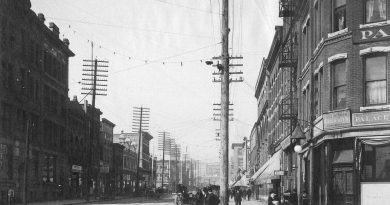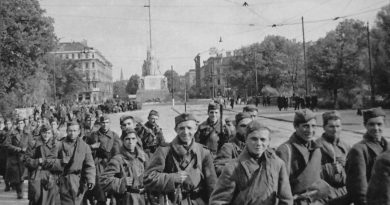The Greenhill Park Explosion
A Vancouver man’s deathbed statement, made nearly 50 years ago and only revealed more than two decades later, throws new light on one of the great events in the city’s history.
If you were here on March 6, 1945, you will remember the waterfront explosion of the 10,000-ton freighter Greenhill Park, easily the most spectacular and disastrous event in the port’s history. Eight longshoremen were killed in that explosion, 19 other workers were injured, seven firemen ended up in the hospital and hundreds of windows in downtown Vancouver, some as far west as Thurlow and as far north as Dunsmuir, were blown out. Whole office blocks had scarcely a pane of glass intact.
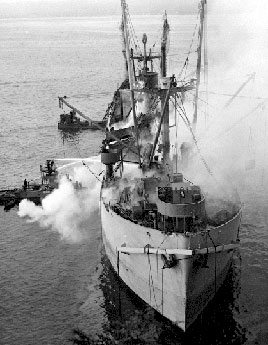
(BC Archives E 03973)
The war against Japan was in its final stages and a lot of people thought the Japanese had begun to bomb the city.
An investigation into the explosion was conducted by the department of transport and presided over by Mr. Justice Sydney Smith. The names of legal personnel involved in that investigation are familiar to any Vancouverite: Brigadier Sherwood Lett was counsel for the ship’s guards, J.V. Clyne was counsel for six of her officers, John Stanton acted for the International Longshoremen’s Union and Walter Owen for the National Harbors Board.
Mr. Justice Smith’s report was released May 12, 1945, two months after the blast. It concluded that the explosion had resulted from “improper stowage of combustible, dangerous and explosive material … and the ignition thereof by a lighted match.”
But that was an educated guess. In such an explosion no match, of course, would ever be found.
But back when I was writing my history column for the Province I got a letter (it was 1980) from a Vancouver reader who thought it was time “the true story was known.” The letter read, in part, “This was told to me in confidence by a man I will call Joe, which was not his name, when we were both in hospital in 1957.”
Accompanying the letter was a sheet of paper headed, “The True Story of the Fire and Explosion on the S.S. Greenhill Park, March 6, 1945.”
I read it and knew I had something. So, in my next column, I asked the man who had sent the letter to call me. He did.
“You’ll have to speak up,” he told me. “I’m 91, and I don’t hear very well. But I remember very clearly. It was 1957 and Joe and I happened to be in hospital together, both awaiting major operations. He was in there for a gall bladder operation. Well, he must have had some sort of premonition of what was going to happen to him because he told me—in confidence—what had happened that day on the Greenhill Park. Joe was a very quiet man and never mingled with the other patients and I’m sure he was always too scared to tell this story before. He seemed to feel he could tell me.
“The main cargo of the ship was sodium chlorate but a fair amount of general cargo was loaded, too. And known supposedly to only a few people was included some barrels of liquor. Well, when this was stowed away, a lot of general cargo was stowed in front of it, so it was well hidden. But Joe said it’s impossible to keep anything like that secret from longshoremen and it wasn’t long before a narrow passage was cleared back to where the liquor was stowed.
“One by one, the men would come down into that hold to draw off a drink, or fill a bottle to take home in a lunch box. The last man to do so had already had a few drinks and he couldn’t see so well down in there.
“So he struck a match.”
A considerable amount of the liquor had been spilled out of the barrels onto the deck and that narrow passage was full of fumes—so, immediately, there was an explosion. That man was killed instantly. There was only one other man in the hold at the moment. That was Joe.
“He grabbed his lunch bucket and climbed up to the deck as fast as he could go and, as he was getting over the rail, the first big explosion went off, blowing him right across the dock. But it was low tide and the deck of the ship was almost level with the dock and he was just bruised a bit. Well, he stood up after rolling across the dock and looked down to discover he was still holding on to his lunch box. Then he ran home. Now that was March 6, 1945. And he never told anyone this story until we met in hospital in 1957. He said he was too scared to do so.”
For 12 years, “Joe” had kept his story to himself. And then, because of a premonition of his fate in that hospital, he told it to a fellow patient. A week later, Joe was dead.
And then, in 1980, Joe’s hospital friend, reading and enjoying my Sunday Vancouver stories in The Province, thought I might want to tell you this one.
Four explosions wracked the Greenhill Park, blew a gaping hole in her side and killed eight longshoremen working aboard her.
An investigation conducted by the department of transport, and presided over by Justice Sydney Smith, brought in a finding two months after the explosion that made an astonishingly good guess at what had actually happened. I call it a guess because no one during the investigation described what had actually happened in Hold No. 3. That didn’t happen until Joe’s statement came to light.
Bob McColm was a 24-year-old fireman in Vancouver, only a year on the force, and he’ll never forget that day—partly because of the explosions (which he clearly heard in his home halfway across town at East 18th and Inverness) and partly because his wife had had a baby that day. He was off shift but it wasn’t long before he got a phone call instructing him to get down to the waterfront—fast.
McColm didn’t have a car, so that meant a ride on the streetcar.
“When I got there,” he told me for that 1980 column, “the place was a hell of a mess. One of the explosions had gone off under the ship’s canteen and the dock was covered with chocolate bars, cigarettes and candy, just all over the place. I was working under Captain Bob Sowden, a hell of a man. He wouldn’t send any of his men any place he wouldn’t go himself and he took me and another young fellow and we actually went aboard the ship while it was still burning. Some of the fellows from No. 1 Company had been aboard her to see if they could find anyone to take off and they’d left, and now the ship was sitting out a couple of hundred yards in the harbor while they got some tow-lines on her. We were taken out to her in a small boat and we went aboard. The water was ankle-deep on the deck in some places and it was damned near boiling. I burned the soles right off my boots before we got off. At one point, we walked on what we thought was a bolt of cloth. It turned out to be a body. It was a hellish scene.
“Anyway, we got a hose aboard from the fire barge but it was a three-inch hose and the department had 2½-inch connections, so that slowed us down a bit. They finally got the tow-lines onto the ship and took her away to beach her, and they let the three of us get off en route. The city fired me six months later,” he said, laughing, “because my brother came back from the air force and there was a regulation that brothers couldn’t work in the department at the same time—and he had seniority.”
The tug that towed the Greenhill Park to beach it at Siwash Rock, the R.F.M., was skippered by Capt. Harry Jones. I was delighted to discover that Capt. Jones was still around (in 1980), living in Vancouver, and that he had read the article. He was 101 years old.
Sid Godber won’t ever forget the day of the Greenhill Park, either — but he’d like to. Sid, who lived in Penticton when I wrote that 1980 column, was a young reporter in March of 1945 who, a day before the explosion, had left the Province for a job on the Vancouver Sun. Sid, on the scene within minutes, frantically began writing down details of the event and interviewing eyewitnesses. Then, notebook in hand, he ran to a phone—and called the wrong newspaper! In the excitement, he completely forgot he’d left the Province and gave the whole story to a startled rewrite man in their office—who was, needless to say, deeply grateful. It took Sid a while to live that down.
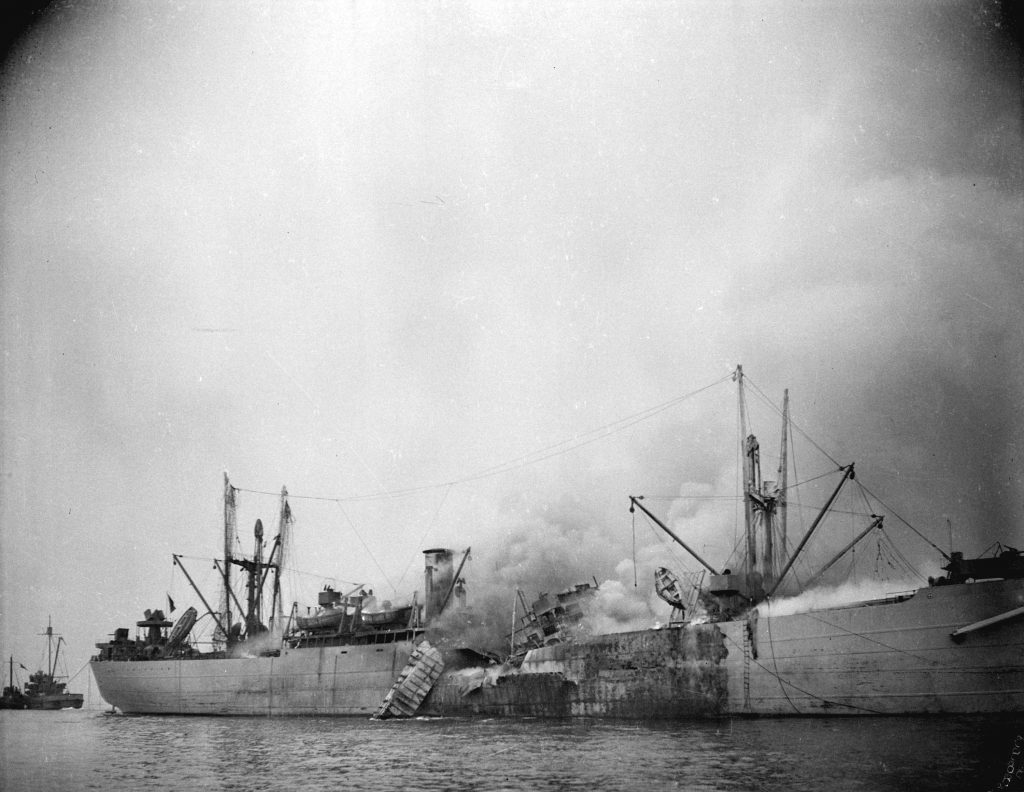
[Image: Vancouver City Archives]
This brief article can’t tell the whole story of the Greenhill Park, of course. That would take a book. In fact, it did: The Smith investigation was 1,500 pages long. It named and censured five officials who, it said, “contributed to the casualty” and expressed real suspicion about the behavior of the eight longshoremen assigned to work in Hold No. 3, where the fire began (these eight men were not identical, in every case, to the eight who died.): “We do not think we were told the whole story by the eight longshoremen who were employed in No. 3 ‘tween decks, or at least not by all of them.
“Furthermore, we are unable to give full credence to the evidence they did give. They all seemed to show great anxiety to negative (sic) any idea of smoking in No. 3 ‘tween decks that morning. And yet we are quite satisfied there was smoking there.”
Evidence had been given that more than one longshoreman had been smoking aboard the Greenhill Park. (The Longshoremen’s Union, incidentally, complained bitterly—and correctly—that their men had not been told of the hazardous nature of the sodium chlorate part of the cargo. Under a wide variety of circumstances, this chemical is explosive.)
The report also said, “. . . we think the true explanation of the speedy spreading of the fire was that whisky escaped from one or more of the barrels, spilled into the surrounding combustible cargo and was ignited by a lighted match carelessly dropped by a longshoreman in the vicinity.”
And the report said that the court had come to the conclusion that the liquor barrels had been tampered with. Reference was made to the discovery after the explosion of lunch pails specially soldered to carry liquids and of hot-water bottles sewn on the inside of a jacket similar to that worn by longshoremen.
“It seems to us,” the report said, “that these were there for the express purpose of carrying away pilfered whisky.”
In June of 1946, the Greenhill Park, repaired, sailed away from Vancouver as the S.S. Phaex II under the new ownership of a Greek company. By 1967, as the Lagos Michigan, she was sold to Formosan shipbreakers for scrap.

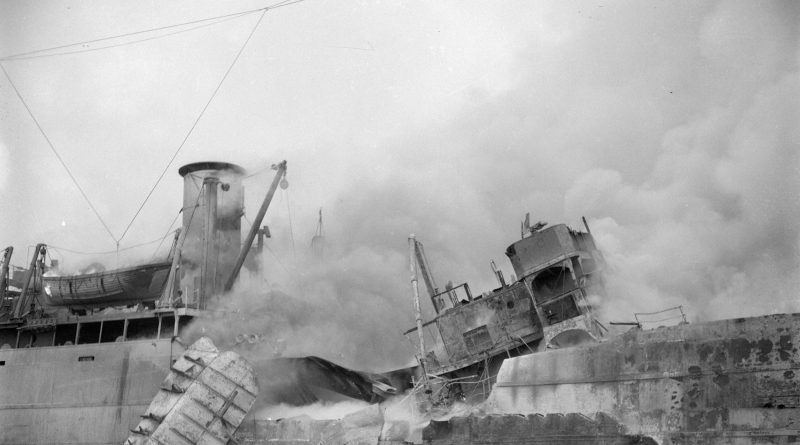
![The trans-continental train, The Canadia. [Image: Derek Low]](https://vancouverhistory.ca/wp-content/uploads/2021/01/6-3-390x205.jpg)
